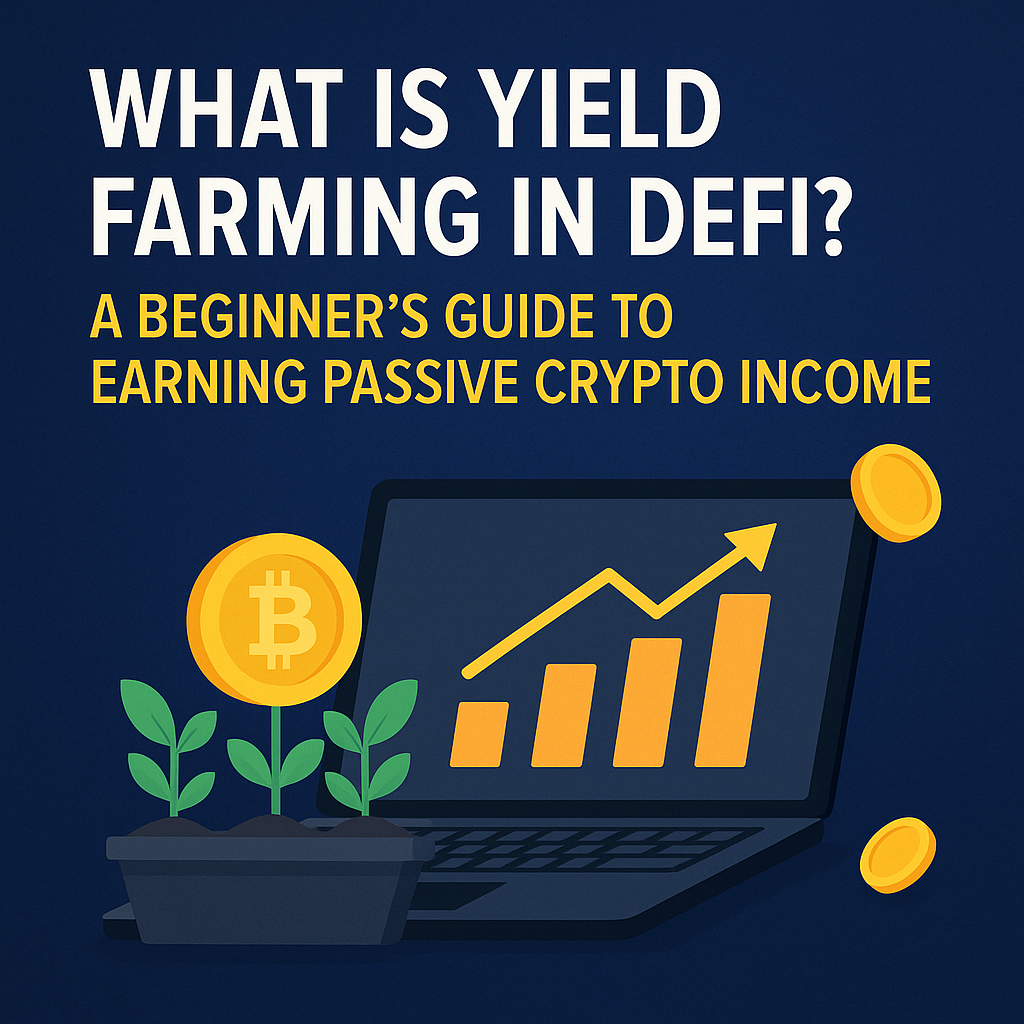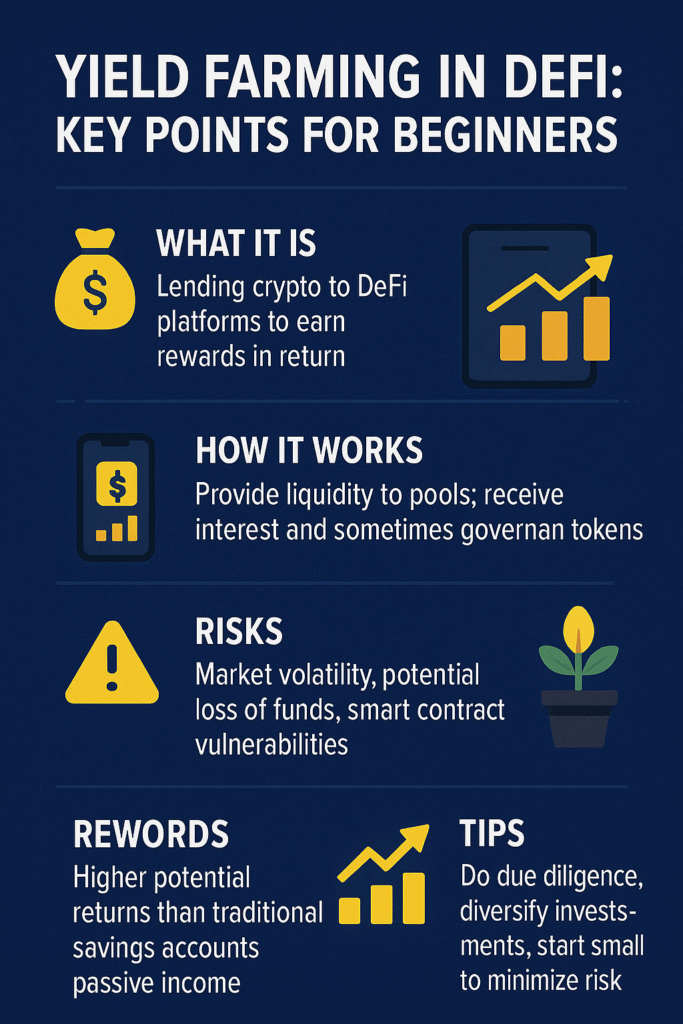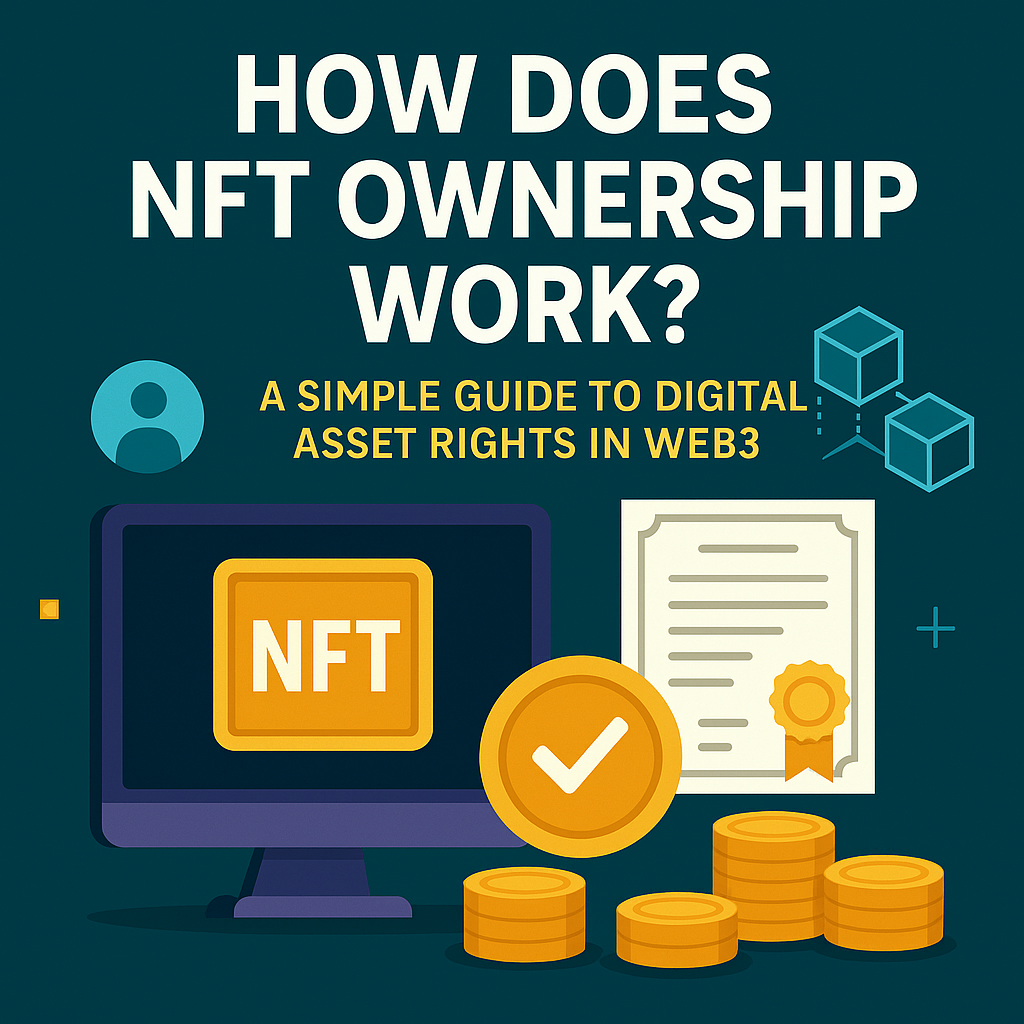
“In DeFi, your money doesn’t sleep. It farms.”
Yield farming is one of the most popular — and complex — ways to earn passive income with your crypto. But what exactly is it? How does it work? And is it worth the risk?
In this post, we’ll break down everything you need to know about yield farming, how to get started, and how to stay safe while maximizing rewards.
📘 Table of Contents
- What Is Yield Farming?
- How Yield Farming Works
- Key Terms You Should Know
- Where Yield Comes From in DeFi
- Platforms That Offer Yield Farming
- Pros and Cons of Yield Farming
- Yield Farming vs Staking vs Liquidity Mining
- Case Study: Real Example of Yield Farming
- Risks Involved in Yield Farming
- Bonus Tips to Maximize Returns
- FAQs
- Our Thoughts: Is Yield Farming Worth It in 2025?
- Final Thoughts + Trusted Tools
1. 🌾 What Is Yield Farming?

Yield farming is the process of earning rewards (usually crypto tokens) by depositing your assets into DeFi protocols.
In simple terms:
You lend or lock up your crypto → DeFi platform uses it → You earn interest or rewards.
💬 “It’s like putting your crypto in a high-interest bank — but with much higher risks and rewards.”
2. ⚙️ How Yield Farming Works
Here’s the basic workflow:
- You deposit tokens into a liquidity pool (e.g., ETH + USDT)
- The pool is used by traders or borrowers
- In return, you receive:
- Interest
- Fees
- Bonus tokens (e.g., farming rewards like CAKE, UNI)
Many yield farms involve multiple DeFi layers and may require LP (liquidity provider) tokens.
3. 🧠 Key Terms to Know
| Term | Meaning |
|---|---|
| APY | Annual Percentage Yield – total returns over a year, with compounding |
| LP Tokens | Tokens representing your share in a liquidity pool |
| TVL | Total Value Locked – the total funds in a DeFi protocol |
| Impermanent Loss | Temporary loss of funds due to price fluctuations in pools |
| Farm Token | Reward tokens (e.g., SUSHI, AAVE) earned during farming |
4. 💸 Where Yield Comes From
| Source of Yield | Explanation |
|---|---|
| 💱 Trading Fees | Users pay fees to swap tokens |
| 🧾 Lending Interest | Borrowers pay to use your crypto |
| 🪙 Incentive Tokens | Platforms issue extra tokens to attract liquidity |
| 🌾 Staking Multipliers | Some farms boost yield if you stake native tokens |
Example: On PancakeSwap, you provide BNB + BUSD → earn 0.25% swap fees + CAKE rewards.
5. 🔝 Popular Yield Farming Platforms
| Platform | Chain | Features |
|---|---|---|
| Aave | Ethereum, Polygon | Lending & borrowing with stable returns |
| Curve | Ethereum, Arbitrum | Stablecoin-focused pools |
| Uniswap | Ethereum | LP fees + token farming (via integrations) |
| PancakeSwap | BNB Chain | Easy UI, yield farms with CAKE rewards |
| Yearn Finance | Multi-chain | Aggregator that auto-optimizes yield |
6. ✅ Pros and ❌ Cons of Yield Farming
| Pros | Cons |
|---|---|
| 🔁 Earn passive income | ⚠️ High risk of impermanent loss |
| 🔥 High APYs available | 📉 Volatile rewards |
| 🧠 Learn DeFi mechanisms | 🐛 Smart contract bugs possible |
| 🌍 Borderless access | 💸 Gas fees can be high on Ethereum |
7. 🔍 Yield Farming vs Staking vs Liquidity Mining
| Feature | Yield Farming | Staking | Liquidity Mining |
|---|---|---|---|
| Asset Movement | Requires LP tokens | Lock a single token | Provide liquidity + get rewarded |
| Returns | High APY, volatile | Fixed APR (usually lower) | Similar to farming but may be simpler |
| Risk Level | High | Low–Medium | Medium–High |
🧠 Yield farming is dynamic, staking is static.
8. 📚 Case Study: Yearn Vault Example
Yearn USDC Vault:
- Users deposit USDC
- Yearn automatically deploys it across Curve, Aave, Compound
- Users earned ~8.2% APY in 2024
🔎 Outcome:
- Set-and-forget strategy
- Safer than manual farming
- Ideal for busy investors
9. ⚠️ Risks in Yield Farming
| Risk | Example |
|---|---|
| Impermanent Loss | Pooling ETH + USDT, ETH pumps → value drops |
| Smart Contract Bug | Exploits in poorly audited protocols |
| Rug Pulls | Anonymous devs drain funds |
| Price Volatility | Rewards fluctuate, reducing actual returns |
| Regulatory Risk | DeFi is not regulated in many countries |
✅ Stick to audited protocols with active communities.
10. 🎯 Bonus Tips to Maximize Yield Farming Returns
- 💡 Start Small: Test with small funds
- 🔒 Use Hardware Wallets: Secure your assets
- 📚 Research Projects: Who built it? Is it audited?
- 📉 Monitor APY Fluctuations: High APYs often drop fast
- 📦 Consider Auto-Compounders: Like Beefy, Autofarm
- 🧾 Track Taxes: Yield farming may trigger taxable events in India
11. ❓ FAQs
Q1: Is yield farming safe?
Not entirely. Rewards are high, but so are risks. Use trusted platforms only.
Q2: Can I yield farm with stablecoins?
Yes! Platforms like Curve and Aave offer safer, lower-yield options with USDC, DAI, etc.
Q3: Is impermanent loss permanent?
It’s temporary unless you withdraw when tokens are imbalanced. Still, it’s a real risk.
Q4: Can I yield farm on mobile?
Yes, with wallets like Trust Wallet + dApps like PancakeSwap, Beefy.
12. 🧠 Our Thoughts: Is Yield Farming Still Worth It?
In 2025, yield farming is maturing, but easy 1000% APYs are gone. Sustainable farming now comes from:
- Stablecoin strategies
- Long-term staking programs
- Protocols with real revenue
For beginners:
- Start with liquid staking or auto-compounding vaults
- Don’t chase every new farm — you might get rugged
For pros:
- Yield stacking, leveraged farming, and governance rewards still offer alpha
💬 “The goal of yield farming is not to get rich overnight — it’s to grow your crypto consistently, with risk in check.”
🔗 Resources & Tools
- DeFiLlama.com – TVL & protocol tracking
- Yearn.finance – Auto-yield platform
- Beefy.finance – Yield aggregator
- Curve.fi – Stablecoin liquidity pools
- Zapper.fi – Yield dashboard & analytics
✅ Final Summary
You’ve now mastered:
- What yield farming is
- How to do it safely
- How it compares with staking
- Where to find real, sustainable yield
Yield farming is powerful — but only if used wisely.

